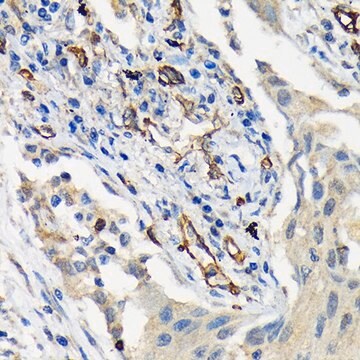MAB16985
Anti-MCAM Antibody, clone P1H12
clone P1H12, Chemicon®, from mouse
Sinónimos:
CD146 antigen, Cell surface glycoprotein P1H12, Melanoma-associated antigen A32, Melanoma-associated antigen MUC18, S-endo 1 endothelial-associated antigen, melanoma adhesion molecule, melanoma cell adhesion molecule
About This Item
Productos recomendados
biological source
mouse
Quality Level
antibody form
purified immunoglobulin
antibody product type
primary antibodies
clone
P1H12, monoclonal
species reactivity
mouse, canine, human
should not react with
rat
packaging
antibody small pack of 25 μg
manufacturer/tradename
Chemicon®
technique(s)
ELISA: suitable
flow cytometry: suitable
immunocytochemistry: suitable
immunohistochemistry: suitable
immunoprecipitation (IP): suitable
western blot: suitable
isotype
IgG1
suitability
not suitable for immunohistochemistry (Paraffin)
NCBI accession no.
UniProt accession no.
shipped in
ambient
storage temp.
2-8°C
target post-translational modification
unmodified
Gene Information
human ... MCAM(4162)
General description
Specificity
Immunogen
Application
1-10 μg/mL of a previous lot worked in immunocytochemistry.Works best on EDTA or Trypsin lifted endothelial cells.
Immunohistochemistry:
1-10 µg/mL. 4% PFA for 30min RT or <2hrs at 4°C. Block w/ 1%BSA/0.2% tween20/PBS for 30min. Works well in frozen tissue; fixed or unfixed.
Immunoprecipitation:
1-10 μg/mL of a previous lot worked in immunoprecipitation.
ELISA:
1-10 μg/mL of a previous lot worked in ELISA.
FACS Analysis:
1-10 μg/mL of a previous lot worked in FACS.
Optimal working dilutions must be determined by end user.
Quality
Western Blot Analysis:
1:500 dilution of this lot detected MCAM on 10μg of HUVEC lysates.
Target description
Physical form
Analysis Note
HUVEC cells.
Other Notes
Legal Information
¿No encuentra el producto adecuado?
Pruebe nuestro Herramienta de selección de productos.
Storage Class
12 - Non Combustible Liquids
wgk_germany
WGK 2
flash_point_f
Not applicable
flash_point_c
Not applicable
Certificados de análisis (COA)
Busque Certificados de análisis (COA) introduciendo el número de lote del producto. Los números de lote se encuentran en la etiqueta del producto después de las palabras «Lot» o «Batch»
¿Ya tiene este producto?
Encuentre la documentación para los productos que ha comprado recientemente en la Biblioteca de documentos.
Nuestro equipo de científicos tiene experiencia en todas las áreas de investigación: Ciencias de la vida, Ciencia de los materiales, Síntesis química, Cromatografía, Analítica y muchas otras.
Póngase en contacto con el Servicio técnico